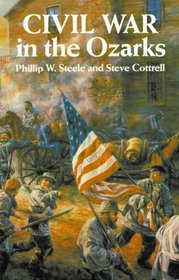Noting the many times it has been reprinted, I suspect this book sells well in gift shops in the South. Worldcat shows it to be uncommon in the Far West, held by many libraries along the Mississippi River and by some libraries on the East Coast.
It is well illustrated (the authors include photos of reenactments) and the captions are carefully written. The frontispiece is a well drawn map.
Reading the first chapter, I found it to be a description of the battles and skirmishes in this area in 1861. Commanders, troops, movements, etc. are detailed. The next chapter covers 1862, the following chapter is 1863, then 1864-1865. There are two added chapters, one on 'Lost Treasures' and the other on the James/Younger exploits apparently added to pad the book. The first is highly unlikely (unless it was CSA paper money) and the second reflects the viewpoint of Lost Cause advocates.
"Capt. Edgar Barker led his detachments of the 2nd Kansas Cavalry and the 1st Kansas Colored Infantry consisting of some 125 Federal troops. Found making hay along the river valley, Barker deployed his forces in the ravine. Cabin Creek was polled every 100 yards with lagoons, and the banks were steep. Confederates then attacked the Federals from five locations. Within half an hour the better prepared Federal forces repulsed three Confederate charges. The Black troops had been warned that the Confederates would give them 'no quarter,' which encouraged them to fight with a tenacity knowing no equal. The battle lasted some two hours as the Confederate forces' strength finally took advantage of the tired Federal resistance. 'The setting sun witnessed our complete success as its last lingering rays rested upon a field of blood. Seventy three Federals, mostly Negroes, lay dead,' General Gano later wrote about the encounter. Confederates further reported that they captured 85 Federal troops, their hay mowing machine, and some 3,000 tons of hay in the affair. Within 24 hours another battle would begin that would bring the Confederacy its greatest victory in Indian Territory."
Bibliography, index.
It is well illustrated (the authors include photos of reenactments) and the captions are carefully written. The frontispiece is a well drawn map.
Reading the first chapter, I found it to be a description of the battles and skirmishes in this area in 1861. Commanders, troops, movements, etc. are detailed. The next chapter covers 1862, the following chapter is 1863, then 1864-1865. There are two added chapters, one on 'Lost Treasures' and the other on the James/Younger exploits apparently added to pad the book. The first is highly unlikely (unless it was CSA paper money) and the second reflects the viewpoint of Lost Cause advocates.
"Capt. Edgar Barker led his detachments of the 2nd Kansas Cavalry and the 1st Kansas Colored Infantry consisting of some 125 Federal troops. Found making hay along the river valley, Barker deployed his forces in the ravine. Cabin Creek was polled every 100 yards with lagoons, and the banks were steep. Confederates then attacked the Federals from five locations. Within half an hour the better prepared Federal forces repulsed three Confederate charges. The Black troops had been warned that the Confederates would give them 'no quarter,' which encouraged them to fight with a tenacity knowing no equal. The battle lasted some two hours as the Confederate forces' strength finally took advantage of the tired Federal resistance. 'The setting sun witnessed our complete success as its last lingering rays rested upon a field of blood. Seventy three Federals, mostly Negroes, lay dead,' General Gano later wrote about the encounter. Confederates further reported that they captured 85 Federal troops, their hay mowing machine, and some 3,000 tons of hay in the affair. Within 24 hours another battle would begin that would bring the Confederacy its greatest victory in Indian Territory."
Bibliography, index.




